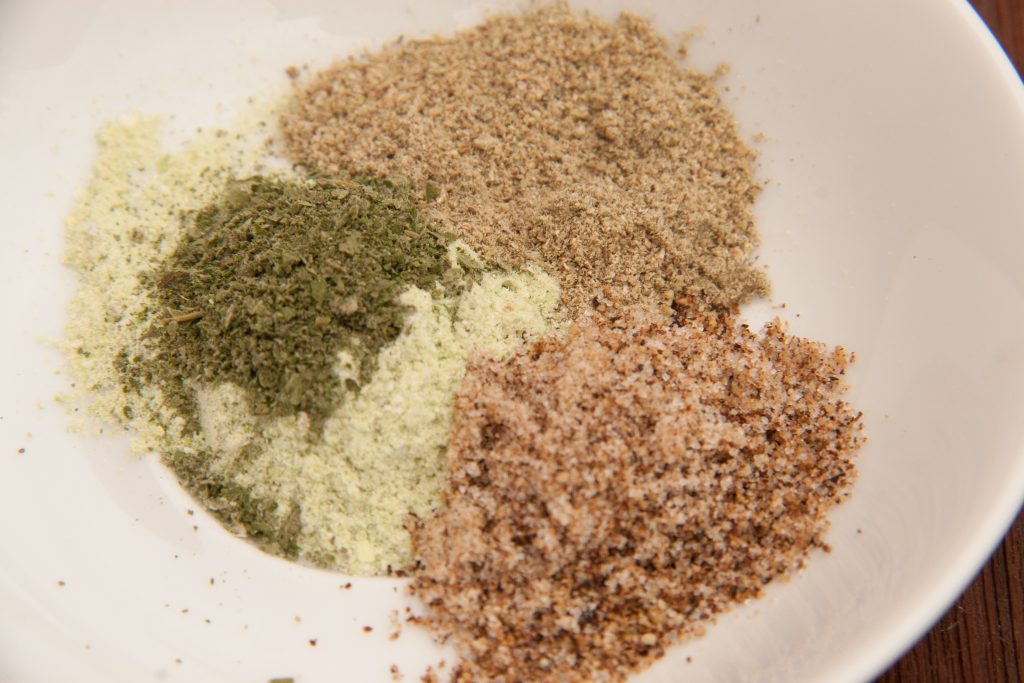
Have you ever asked yourself, “What does HERE taste like?” Foraging for local herbs and spices lets you add unique flavors to all sorts of dishes; combine your favorites in an easy foraged dry rub.
Winter is a great time to play with the herbs and spices you dried during the growing season. This particular dry rub embodies the flavors of northeastern Pennsylvania; every one of these plants grows within a few miles of my home in Pike County. Depending on where you live, you may make some substitutions, so don’t worry if you can’t find exactly the same plants. The idea is to create your own, unique blend of flavors that embodies the flavors of your own “here.”
A few basics:
1) Harvest your spices and herbs when they’re at their peak. Peak season is different for each plant. For example wild garlic bulbs are most delicious in early spring, while spicebush berries must be harvested in fall.
2) We may use the words herb and spice interchangeably in the kitchen, but technically an herb is the leafy part of a plant and a spice is the bark, root, or seed. Some sources consider flowers to be spices, but I classify them as herbs, since they are delicate, soft plant tissues and should be dried with the same care you’d give to leafy herbs. Dry your herbs at low temperatures, approximately 95F. This leaves the essential oils intact. Spices can be dried at slightly higher temperatures, approximately 125F.
3) Store your dried herbs and spices in individual air-tight containers, out of direct sunlight.
4) Don’t grind your spices and herbs until just before using. Your herbs and spices will stay fresh longer the less surface area is exposed to the air.
5) Buy yourself a dedicated spice grinder. If you use your coffee bean grinder for grinding spices, all your spices will taste like coffee!
6) There’s no equation I know of to estimate exactly how much whole herb to start with in order to get a certain amount of powdered herb. Start with about 1/3 more volume than you want to end up with. In other words, 1 1/2 teaspoons of dried wild garlic bulb will yield approximately 1 teaspoon of wild garlic powder. Adjust as needed.
What You’ll Need to Make Your Foraged Dry Rub
- 1 tsp. powdered, dehydrated wild garlic bulbs (you may substitute any local allium)
- 1/4 tsp. powdered, dried bee balm leaves or flowers (you may substitute oregano)
- 1/2 tsp. powdered, dehydrated wild ginger root (you may substitute powdered tropical ginger, or, if you’d like to keep it wild but don’t have local ginger, think of something earthy, spicy, and sweet, like sassafras or carob)
- 1/2 tsp. powdered, dried spicebush berries (you may substitute half pepper and half allspice, or try juniper berries or dried sweet fern leaves)
- 1 tsp. brown sugar
- 1 tsp. salt
What You’ll Do to Make Your Foraged Dry Rub
Individually grind each of the four herbs into a powder, then combine them in a small bowl and stir well. (If you have extra (because it really is hard to estimate exactly how much powder you’ll get from the whole spice or herb), save it to add to your next batch of rice or salad dressing.) Add the sugar and salt and taste, then adjust as needed.
Dredge your chicken or pork in the dry rub, covering all sides. Let the dry rub sit 3 – 4 hours or overnight, then grill or bake as you please.
do you have some recipes for spicebush twig or how to preseved them?
Thanks a lot
I don’t find that spicebush twigs have very much flavor. Some people make tea from the leaves and twigs, but to me the fruit is much more flavorful. I’ve made a syrup and a liqueur from the twigs and leaves, but the flavor was so mild, I don’t recommend it. That’s just my personal taste…maybe you’ll love a tea made from the twigs and leaves. I prefer stronger flavors.
[…] boiled and simmered to extract the fragrant oils in decoctions or teas. Consider recipes such as spicebush dry rub, or spicebush […]